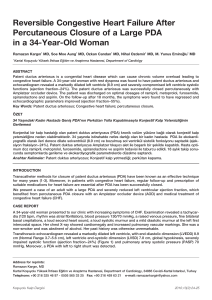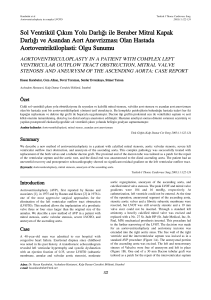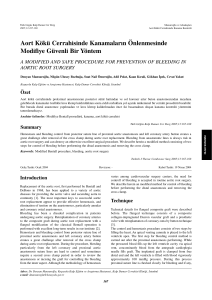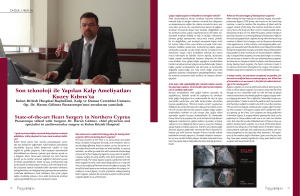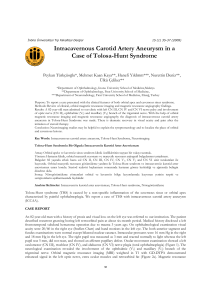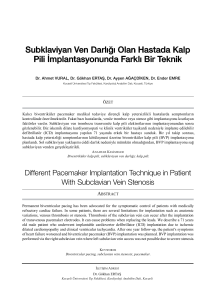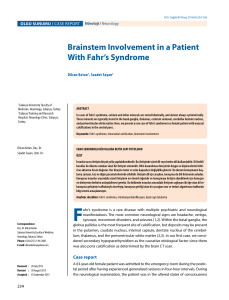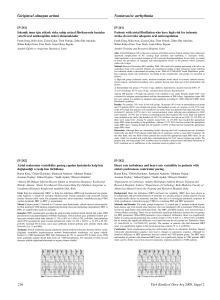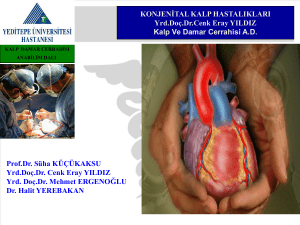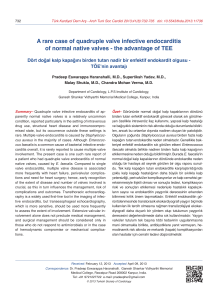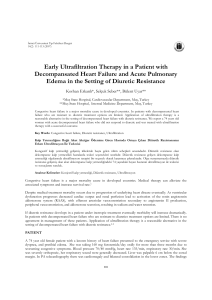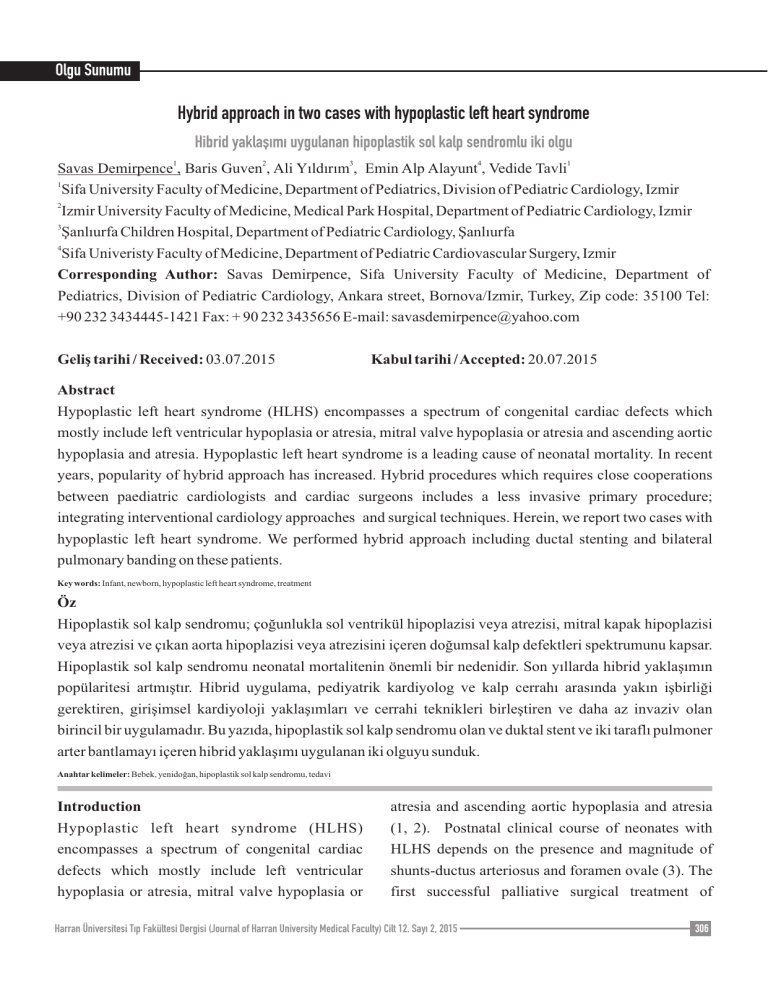
Olgu Sunumu
Hybrid approach in two cases with hypoplastic left heart syndrome
Hibrid yaklaşımı uygulanan hipoplastik sol kalp sendromlu iki olgu
Savas Demirpence1, Baris Guven2, Ali Yıldırım3, Emin Alp Alayunt4, Vedide Tavli1
1
Sifa University Faculty of Medicine, Department of Pediatrics, Division of Pediatric Cardiology, Izmir
2
Izmir University Faculty of Medicine, Medical Park Hospital, Department of Pediatric Cardiology, Izmir
3
Şanlıurfa Children Hospital, Department of Pediatric Cardiology, Şanlıurfa
4
Sifa Univeristy Faculty of Medicine, Department of Pediatric Cardiovascular Surgery, Izmir
Corresponding Author: Savas Demirpence, Sifa University Faculty of Medicine, Department of
Pediatrics, Division of Pediatric Cardiology, Ankara street, Bornova/Izmir, Turkey, Zip code: 35100 Tel:
+90 232 3434445-1421 Fax: + 90 232 3435656 E-mail: [email protected]
Geliş tarihi / Received: 03.07.2015
Kabul tarihi / Accepted: 20.07.2015
Abstract
Hypoplastic left heart syndrome (HLHS) encompasses a spectrum of congenital cardiac defects which
mostly include left ventricular hypoplasia or atresia, mitral valve hypoplasia or atresia and ascending aortic
hypoplasia and atresia. Hypoplastic left heart syndrome is a leading cause of neonatal mortality. In recent
years, popularity of hybrid approach has increased. Hybrid procedures which requires close cooperations
between paediatric cardiologists and cardiac surgeons includes a less invasive primary procedure;
integrating interventional cardiology approaches and surgical techniques. Herein, we report two cases with
hypoplastic left heart syndrome. We performed hybrid approach including ductal stenting and bilateral
pulmonary banding on these patients.
Key words: Infant, newborn, hypoplastic left heart syndrome, treatment
Öz
Hipoplastik sol kalp sendromu; çoğunlukla sol ventrikül hipoplazisi veya atrezisi, mitral kapak hipoplazisi
veya atrezisi ve çıkan aorta hipoplazisi veya atrezisini içeren doğumsal kalp defektleri spektrumunu kapsar.
Hipoplastik sol kalp sendromu neonatal mortalitenin önemli bir nedenidir. Son yıllarda hibrid yaklaşımın
popülaritesi artmıştır. Hibrid uygulama, pediyatrik kardiyolog ve kalp cerrahı arasında yakın işbirliği
gerektiren, girişimsel kardiyoloji yaklaşımları ve cerrahi teknikleri birleştiren ve daha az invaziv olan
birincil bir uygulamadır. Bu yazıda, hipoplastik sol kalp sendromu olan ve duktal stent ve iki taraflı pulmoner
arter bantlamayı içeren hibrid yaklaşımı uygulanan iki olguyu sunduk.
Anahtar kelimeler: Bebek, yenidoğan, hipoplastik sol kalp sendromu, tedavi
Introduction
Hypoplastic left heart syndrome (HLHS)
encompasses a spectrum of congenital cardiac
defects which mostly include left ventricular
hypoplasia or atresia, mitral valve hypoplasia or
atresia and ascending aortic hypoplasia and atresia
(1, 2). Postnatal clinical course of neonates with
HLHS depends on the presence and magnitude of
shunts-ductus arteriosus and foramen ovale (3). The
first successful palliative surgical treatment of
Harran Üniversitesi Tıp Fakültesi Dergisi (Journal of Harran University Medical Faculty) Cilt 12. Sayı 2, 2015
306
Hybrid approach in hypoplastic left heart syndrome
neonates with HLHS was performed by Dr.
William Iman Norwood and colleagues in 1981
(3). Norwood operation (stage I) connects right
ventricle to both the systemic and pulmonary
circulations. Bi-directional cavopulmonary
anastomosis (BCPA) and Fontan procedures
should be performed by 4-6 months and 2-4 ages,
respectively to unload systemic right ventricle.
During the last decade, alternative options such as
hybrid palliation became available. Adequate
interatrial communication with septostomy +/stent, ensuring the patency of the ductus arteriosus
to maintain systemic blood flow and protecting the
pulmonary vascular bed by performing bilateral
pulmonary arterial banding is aimed for this
approach (4,5). In this report, we describe two
neonate with HLHS who had hybrid approach.
Case 1
A 39-week neonate weighing 3815 gr was referred
to our unit for the evaluation of tachypnea and low
saturation. On physical examination, patient was
cyanotic with a pulse oximeter reading 78%. His
precordium was active with a hyperdynamic right
ventricular impulse with normal peripheral pulses,
and a grade 2/6 systolic ejection murmur heard
along the mesocardiac area. A mild hepatomegaly
was noted, and lung auscultation was normal. An
echocardiogram showed a hypoplastic left
ventricle, large secundum atrial septal defect and
patent ductus arteriosus. Left ventricular end
diastolic dimension was 7 mm, aortic valve
annulus was 4 mm, isthmus and descending aorta
was 5.5 mm and 7 mm, respectively. There were
also mitral and aortic valve atresia. There was no
antegrade flow in the aorta, but retrograde flow
from the ductus to arcus aorta and its branches. We
measured the annulus of atretic aortic valves.
Prostaglandin E1 infusion and diuretic therapy
307
was begun, and decision of hybrid approach was
made. Cardiac catheterisation supported the findings
of echocardiography. Bidirectional shunt through
atrial septal defect with a 9 mm and dilated
pulmonary artery three times aorta and Krichenko
type C ductus with a 6 mm diameter were noted. 8x16
mm balloon-expandable stent (RX Herculink Elite)
was deployed in the ductus. Afterwards, bilateral
pulmonary banding procedure was performed. No
complications were noted after procedure.
Tracheostomy was needed for optimal respiratory
care. After one week of procedure, patient had 32
mmHg gradient through the ductal stent showing
restrictive blood flow. We did not perform
angiography due to sepsis and deterioration in the
clinical picture. Klebsiella pneumonia was isolated
in blood culture. Cultures of urine, tracheal aspirate
and tip of the catheter were negative. The patient was
died on the 39th day postoperatively after sudden
deterioration in general condition and hypotension
low cardiac output due to possible septicaemia.
Case 2
A 38-week old neonate with a suspicion of congenital
heart disease on obstetric ultrasound was referred to
our unit. His birth weight was 3800 gr., baby was
pallor with a heart rate of 174/min and respiratory
rate of 55/min. Blood pressure was 54/31 mmHg.
Patient had 3/6 systolic murmur with a pulse
oximetry reading of % 95, and femoral pulses were
bilaterally palpable. There was no abnormality in
blood tests and biochemistry parameters.
Transthoracic echocardiography revealed
hypoplastic left heart syndrome, secundum atrial
septal defect and patent ductus arteriosus. Left
ventricular end diastolic diameter was 9 mm, aortic
annulus was 4.5 mm, isthmus was 5 mm, and
descending aorta was 7.5 mm. Inotropic support,
diuretic and PGE1 infusion was started. We started
Harran Üniversitesi Tıp Fakültesi Dergisi (Journal of Harran University Medical Faculty) Cilt 12. Sayı 2, 2015
Hybrid approach in hypoplastic left heart syndrome
PGE1 infusion with a dose of 0.01 mcg/kg/min
after immediately birth in case who prenatally
diagnosed. On the second day of hospitalisation,
patient was intubated due to tachypnea and
respiratory acidosis in blood gas analysis. Since,
this baby is term neonate; PGE1 infusion may lead
to abdomical distention, biliary and bloody gastric
residue, which developed on postnatal day 2. We
decided to stop enteral feeding and start antibiotic
therapy due to abdominal distention and biliary,
bloody gastric residues. PGE1 infusions was also
stopped because of necrotizing enterocolitis. The
diagnosis of sepsis and disseminated intravascular
coagulopathy were considered based on increase
of acute phase reactants and alterations in blood
diathesis tests. On day 11 of hospitalisation, the
decision of hybrid approach was made. The length
and diameter of the ductus were determined by
echocardiography and angiography. The
angiography showed atretic mitral and aortic
valves, dilated pulmonary artery, tubular ductus
with a 5 mm. There was bilateral shunt through
ASD with a 7 mm diameter. The same procedures
including 6x18 mm balloon-expandable ductal
stenting (RX Herculink Elite) and bilateral
pulmonary banding were applied in this patient,
and no complications after procedures were
observed. Postoperative echocardiography
demonstrated 12 mmHg peak instantaneous
gradient in stent area. Candida glabrata was
isolated from blood, but urine and tracheal culture
were negative. Patient was lost after 23 days of
procedure due to sepsis with sudden onset of
bradycardia and hypotension.
DISCUSSION
HLHS is a fatal neonatal congenital heart disease
which accounts for 25% of deaths during the first
week of life (4). The first successful palliative
surgery in patients with hypoplastic left heart
syndrome has been succeeded by Norwood et al. in
1981 (3). Stage I Norwood includes atrial
septectomy, anastomosis of proximal pulmonary
artery to aorta, and separation of pulmonary and
systemic circulation using either a right ventricular to
pulmonary artery conduit or a Blalock-Taussig shunt.
Significant success has been recorded in three staged
procedure during the last decade. However, general
morbidity and mortality of the initial Norwood
procedure and its influence on the long-term success
of the following Fontan procedure remain
suboptimal (6). Therefore, during the last decade,
hybrid approach with bilateral pulmonary arterial
banding, stenting of patent ductus arteriosus to
restore unobstructed systemic output and creation of
unobstructed atrial septal defect has been emerged as
an alternative to Norwood operation in children with
HLHS. The decision concerning the individual
strategy in patients with HLHS has changed with
increasing experience in making prenatal and
postnatal diagnosis as well as in surgical palliations
and is now based on medical and social
considerations (7). Compared to almost 30 years of
experience with the Norwood stage I operation the
hybrid approach is relatively new. Originally
reported in 1993, hybrid procedures for initial
palliation of hypoplastic left heart syndrome were
devised as an alternative to the stage 1 Norwood
procedure. Hybrid procedures which requires close
cooperation between the paediatric cardiologists and
cardiac surgeons includes a less invasive primary
procedure; integrating interventional cardiology
approaches and surgical techniques (5).
Ductal stenting is generally recommended
particularly in patients with restrictive ductus
Harran Üniversitesi Tıp Fakültesi Dergisi (Journal of Harran University Medical Faculty) Cilt 12. Sayı 2, 2015
308
Hybrid approach in hypoplastic left heart syndrome
arteriosus not responding to PGE1 therapy. In our
institute, we do not prefer only Hybrid procedure;
we have also experience on Norwood stage I with
either a Sano shunt or modified BT shunt. We
decided to perform Hybrid procedure in these
cases. In our cases, hybrid approach was
successful with no procedure related
complications. We prefer Columbus approach,
which has evolved with the cooperative
modifications of Galantowicz and Chetham (8).
The palliation is performed by intraoperative, offpump, a stent in the arterial duct positioned
through a sheath in the pulmonary trunk followed
by placement of bands on both pulmonary arteries.
Bands are placed surgically round the right and left
pulmonary arteries. Bilateral pulmonary artery
banding and ductal stent implantation were
performed concomitantly. We did not use
angiography to show ductus arteriosus in both
cases. Ductus diameter was measured by
epicardial 2D- echocardiography. The hybrid
approach to palliation of hypoplastic left heart
syndrome can be complicated by the development
of neointimal formation and in-stent stenosis of
the PDA. This may obstruct retrograde aortic arch
flow, decrease systemic circulation, and lead to
interstage interventional procedures (9).
Ventricular functions, degree of tricuspid
regurgitation and peak instantenous gradient
through ductus arteriosus and pulmonary artery
bands should be evaluated by echocardiography
during postoperative period.
We performed hybrid procedure in the sterile
operating room. In the first case, tracheostomy,
which was performed after 32nd day of procedure,
could be the major contributing factor to sepsis. In
the second case, there was clinical picture of
necrotizing enterocolitis before the procedure that
309
may help the progression of sepsis in the
postoperative period. We tried to extubate patients
earlier postoperatively. Several authors suggest that
full mechanical ventilation lessens the burden of
respiratory effort of the patient, and accordingly
eliminates the metabolic demand that spontaneous
respiratory function imposes. However, after 1
month of follow-up, our cases were lost due to sepsis.
Both patients were intubated and had clinical
findings consistent with general septicaemia.
Preoperative hemodynamic findings and the
presence of aortic and mitral atresia concomitantly in
both cases could be associated with this unfavourable
outcome.
Initial reports regarding early results of the hybrid
approach were restricted by small cohorts of patients
with heterogenous diagnoses and risk stratification,
short follow-up period and the effect of the learning
curve of this new method. In recent years, reports
have been focused on the management of hybrid
approach for high risk patient with HLHS. The
results of new reports from several centres
comparing the risks of hybrid approach and Norwood
stage 1 and 2 are promising (10, 11). Several
investigators addressing the potential advantage of
Hybrid approach that there may be a dramatic
improvement of patient's neurological development
by delaying the age of the bypass. However, there is
no definite answer what effect of hybrid approach
will have on neurodevelopmental outcomes in future
(12). In the majority of cases, total cardiac output and
systemic extraction of oxygen are the most
important, most variable, and most manageable
determinants of systemic delivery of oxygen in the
acute post-operative period following the initial
stage. Our both cases had mitral/aortic atresia, which
is a severe form of HLHS; we may argue that the
prognosis could be better if they had mitral
Harran Üniversitesi Tıp Fakültesi Dergisi (Journal of Harran University Medical Faculty) Cilt 12. Sayı 2, 2015
Hybrid approach in hypoplastic left heart syndrome
stenosis/aortic stenosis.
In conclusion, Hybrid approach is an alternative to
the Norwood stage 1 for children with high risk
congenital heart disease. In this report, we
describe two cases with hypoplastic left heart
syndrome who had hybrid approach. Hybrid
approach which mandates multidisciplinary team
References
1.Alayunt EA, Atay Y, Uç H: Hipoplastik Sol Kalp
Sendromu. In: Duran E, ed. Kalp ve Damar Cerrahisi.
1.Baskı. İstanbul; Çapa Tıp Kitabevi ve Yay. Hizmetleri,
Ulus Matbaacılık 2004: 497-508.
2.Pizarro C, Derby CD, Baffa JM, et al. Improving the
outcome of high-risk neonates with hypoplastic left
heart syndrome: hybrid procedure or conventional
surgial palliation. European Journal of Cardio-thoracic
Surgery 2008; 33 (4): 613-18.
3.Norwood WI, Lang P, Casteneda AR, Campbell DN.
Experience with operations for hypoplastic left heart
syndrome. The Journal of thoracic and cardiovascular
surgery 1981; 82 (4): 511–9.
4.Hazan E, Şişli E. Hypoplastic left heart syndrome.
Turkiye Klinikleri J Pediatr Sci 2006; 2 (12): 64-7
including paediatric cardiologists and cardiac
surgeons will have potential for being a primary
treatment modality for high risk HLHS infants, in
future. However, it should also be noted that longterm and multicenter prospective studies are needed
to determine the clinical benefits and risks of this
approach.
5.Bacha E AM, Hijazi ZM. Hybrid Procedures in
Pediatric Cardiac Surgery. Semin Thorac Cardiovasc
Surg Pediatr Card Surg Annu. 2005: 78-85.
6.Ashburn DA, McCrindle BW, Tchervenkov Cl,et al.
Outcomes after the Norwood operation in neonates with
critical aortic stenosis or aortic valve atresia. J Thorac
Cardiovasc Surg 2003; 125 (5): 1070-82.
7.Brackley KJ, Kilby MD, Wright JG, et al. Outcome
after prenatal diagnosis of hypoplastic left-heart
syndrome: a case series. Lancet. 2000; 356
(9236):1143–7.
8.Galantowicz M, Cheatham JP, Phillips A, et al. Hybrid
approach for hypoplastic left heart syndrome:
intermediate results after the learning curve. Ann Thorac
Surg 2008; 85 (6): 2063-70.
Harran Üniversitesi Tıp Fakültesi Dergisi (Journal of Harran University Medical Faculty) Cilt 12. Sayı 2, 2015
9.Robert H. Anderson, Edward J. Baker, Daniel J. Penny,
Andrew N. Redington,, Michael L. Rigby and Gil
Wernovsky. Paediatric Cardiology. 3rd edition. Churchill
Livignstone, Philadelphia, 2010: 978-986.
Nadorlik HA
10.Egan MJ, Hill SL, Cheatham JP, Galantowicz M,
Kovalchin JP. Predictors of ductus arteriosus in-stent
stenosis in the hybrid approach to hypoplastic left heart
syndrome. Pediatr Cardiol. 2013; 34 (3): 656-60.
11.Akintuerk H, Michel-Behnke I, Valeske K, et al. Stenting
of the atrial duct and banding of the pulmonery arteries:
basis for combined Norwood stage 1 and 2 repair in
hypoplastic left heart. Circulation 2002; 105 (9): 1099-103.
12.Licht DJ, Shera DM, Clancy RR, et al. Brain maturation
is delayed in infants with complex congenital heart defects.
J Thorac Cardiovasc Surg 2009; 137 (3): 529-36.
310

